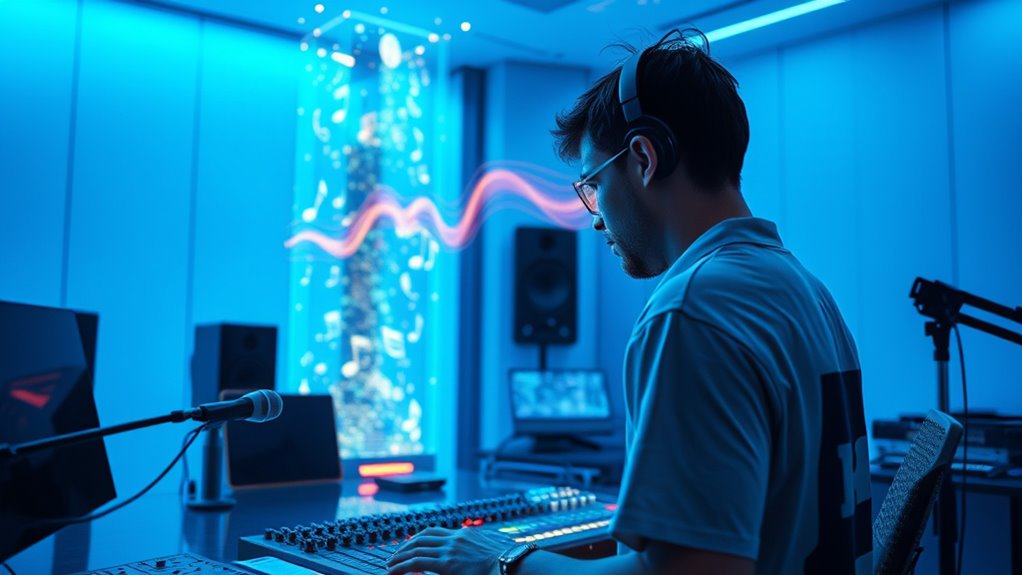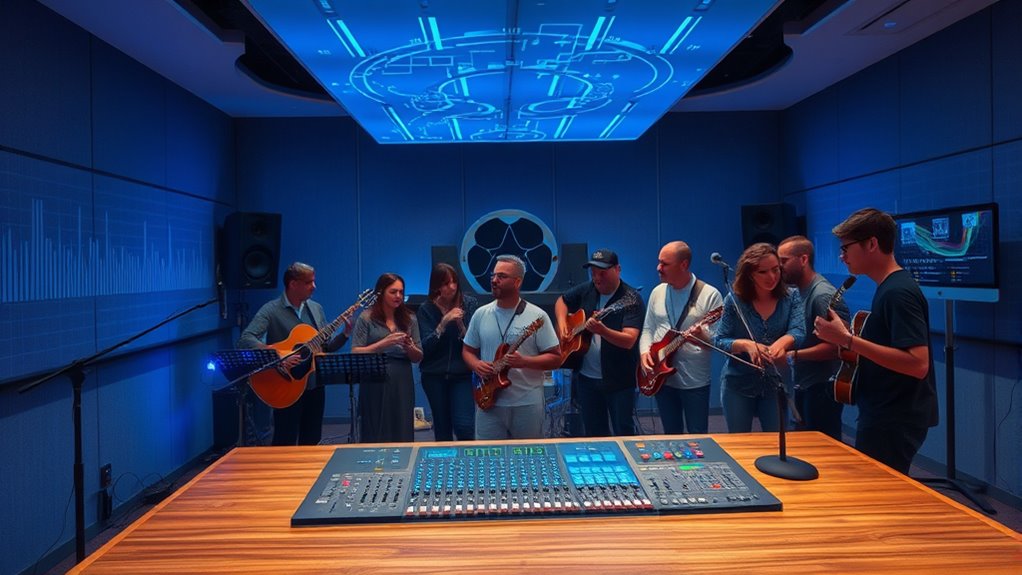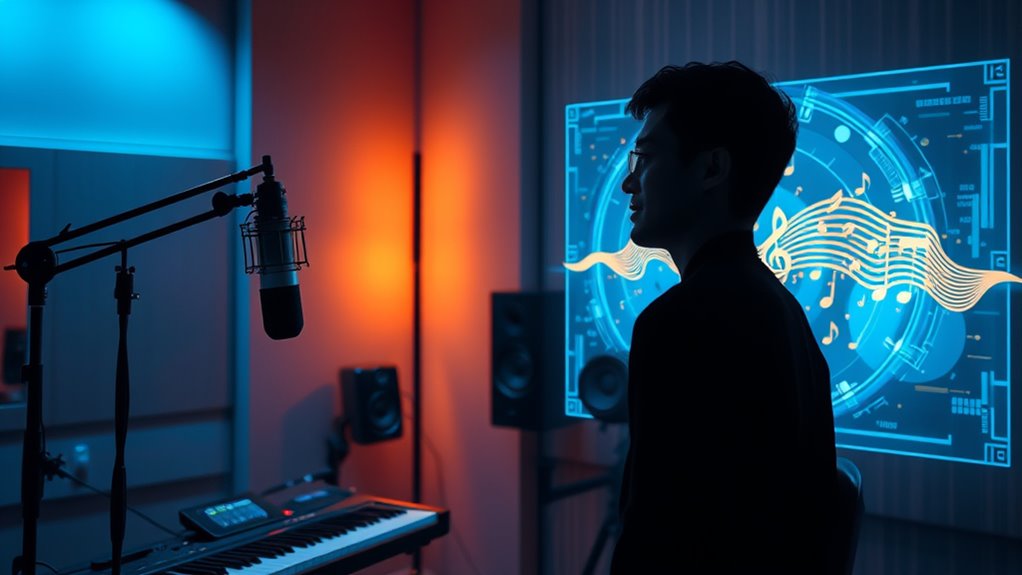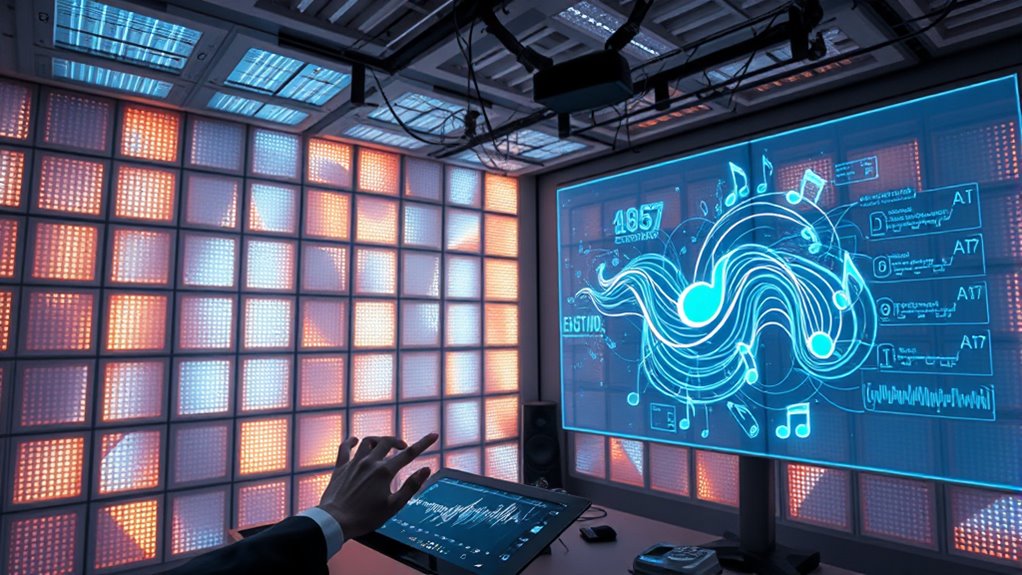AI-generated music can be a powerful tool for creative collaboration, offering new sounds, melodies, and ways to overcome creative blocks. It expands possibilities and helps artists experiment more freely. However, it also raises concerns about authenticity, emotional depth, and ownership, with some fearing it could threaten human artistry. Balancing innovation with responsibility is key, and exploring these challenges reveals how AI is shaping the future of music—and there’s much more to uncover.
Key Takeaways
- AI enhances creative collaboration by offering new tools for composition, sound design, and personalized music experiences.
- It presents a threat to traditional musicians’ jobs and authenticity, raising concerns over artistic integrity and emotional depth.
- Ethical and legal challenges surround ownership rights, attribution, and potential infringement in AI-generated music.
- Industry adoption of AI fosters innovation but requires balancing technological advances with preserving human artistry.
- Responsible development and regulation can turn AI into a complementary partner rather than a destructive threat.
The Evolution of AI in Music Composition

The evolution of AI in music composition shows remarkable progress, transforming from simple algorithms in the 1950s to advanced neural networks today. Early on, rule-based algorithms attempted to generate music, but modern generative AI leverages deep learning to produce complex musical outputs. Color accuracy, which is crucial in visual media, has its own analog in music through the importance of tonal precision and timbre consistency in AI-generated compositions. Neural networks analyze vast datasets of existing music, learning patterns, styles, and structures, enabling the creation of more nuanced compositions. Tools like OpenAI’s Jukebox, Google’s MusicLM, and AIVA use these models to generate full songs from text prompts or parameters. As AI advances, platforms like Amper Music and Landr allow artists to collaborate with algorithms, streamlining production and broadening creative possibilities. This shift from basic algorithms to neural network-driven deep learning marks a significant milestone in music composition’s evolution. Additionally, music datasets are fundamental in training these models to ensure diversity and quality in generated outputs. Moreover, the ongoing refinement of training methods ensures that AI-generated music continues to improve in complexity and emotional expressiveness. Furthermore, advancements in computational power and machine learning techniques enable the handling of larger and more diverse datasets, leading to richer and more authentic musical outputs.
Opportunities and Innovations Enabled by AI

AI has opened new horizons for musicians and producers by enabling them to compose, produce, and master music with unprecedented efficiency. AI tools like AIVA, Amper Music, and Landr expand your creative possibilities, allowing you to craft complex arrangements and soundscapes faster than ever.
Generative AI can produce diverse melodies, textures, and ideas from simple prompts, fueling innovation across genres and encouraging experimentation. These tools help you overcome creative blocks by suggesting new ideas, remixing existing tunes, and creating variations that inspire fresh approaches.
Platforms such as Suno and Adobe’s Project Music GenAI Control enable real-time customization of background music, streamlining your workflow. Overall, AI fosters collaboration and opens exciting avenues for pushing musical boundaries. Supporting creativity through AI can also lead to more emotionally resonant compositions by exploring new soundscapes and textures.
Challenges to Artistic Authenticity and Emotional Depth

You might notice that AI-generated music often feels hollow or lacks the emotional nuance of human performance. Critics argue that without personal experiences and cultural context, AI struggles to create authentic, emotionally resonant songs. This raises questions about whether technology can truly replicate the human touch that makes music deeply meaningful. Furthermore, the complexity of artificial intelligence in understanding nuanced emotional cues presents an ongoing challenge for creating truly authentic compositions. Additionally, cultivating self-awareness can help composers and listeners alike appreciate the unique qualities of human-created music versus AI-generated pieces. Recognizing the importance of emotional depth in musical expression highlights the limitations of current AI capabilities. In the realm of ethical hacking, understanding human factors is essential, as technical prowess alone does not guarantee security or authenticity. Exploring emotional regulation in both AI and human creators may offer insights into developing more authentic artistic expressions.
Emotional Authenticity Concerns
Although AI can generate technically proficient music, many argue it falls short in capturing genuine human emotion. AI-generated music often lacks emotional authenticity and the depth that human artistry naturally provides. Furthermore, the emotional nuances that stem from personal experiences are challenging for AI to authentically replicate, raising questions about the emotional authenticity of artificially created compositions. Listeners often perceive AI-created music as hollow or soulless, highlighting the importance of lived experience in music. Human musicians embed personal stories and emotional nuances that artificial intelligence, which relies solely on pattern recognition, can’t authentically replicate. This raises concerns about AI’s ability to produce music that truly resonates on a deep emotional level. Additionally, questions around copyright law and the preservation of authenticity and soul emerge, as AI challenges traditional notions of creative expression and the human element of human-driven artistry. Moreover, the integration of AI into music production prompts ongoing debates about the creative process and whether technology diminishes or enhances artistic innovation. As the technology advances, the debate continues on how AI can be integrated without compromising the emotional depth that defines human music. Advances in personal creativity can potentially enable AI tools to better mimic emotional expression, but the core challenge remains in capturing authentic human experience.
Human Touch in Music
The human element remains a defining feature of authentic music, shaping performances with emotional nuance and personal experiences that machines can’t replicate. Your human touch brings authenticity and depth, making live performances resonate deeply with audiences. An artist’s performance quality is often enhanced by subtle cues and spontaneous reactions that AI cannot predict or emulate. Emotional expression flows naturally from personal experiences, creating a connection that AI-generated music struggles to match. Critics often find AI music hollow because it lacks empathy and the storytelling inherent in human performances. When you perform live, your vulnerability and emotional nuance foster genuine engagement, something machines can’t evoke convincingly. The true essence of music lies in shared human experiences and the ability to convey complex emotions—qualities rooted in the artist’s personal touch. Additionally, electric capabilities in instruments can influence the expressiveness and authenticity of a performance, emphasizing the importance of human control over technology. These emotional nuances, which are vital for conveying depth, are difficult for AI to replicate convincingly. Without it, music risks feeling soulless and disconnected from its cultural and emotional roots.
AI’s Expressive Limitations
AI-generated music often falls short when it comes to conveying genuine emotion, as it lacks the lived experiences that give human performances depth. Its expressive limitations mean it struggles with authentic emotional expression, resulting in music that can feel hollow or superficial.
To deepen your understanding, consider these points:
- AI can’t grasp the emotional context behind notes, limiting its ability to evoke authentic feelings.
- It tends to remix or imitate styles rather than creating nuanced, emotionally rich improvisation.
- Despite technical proficiency, AI struggles to replicate spontaneous improvisation and emotional vulnerability, essential for emotional depth.
This results in music that often lacks the nuanced, authentic feel that characterizes human artistry, highlighting AI’s current inability to fully capture the emotional spectrum of musical performance.
Navigating Ownership, Copyright, and Ethical Dilemmas

Managing ownership and copyright in AI-generated music presents complex challenges that lawmakers, artists, and tech companies are still trying to resolve. Who owns the rights—the programmer, the guiding artist, or the AI itself? Legal concerns grow as AI models trained on copyrighted songs risk infringement, sparking lawsuits.
One emerging issue involves the sound design process, which traditionally relies on human creativity and technical skill, raising questions about whether AI can truly replicate or replace these aspects. Ethical dilemmas also emerge around attribution of creative credit, questioning whether AI can be considered an author or if humans retain sole ownership. Current copyright laws often fall short for AI-created works, prompting calls for new legal frameworks and licensing standards. Additionally, the divorce laws in various jurisdictions influence how disputes over AI-generated content might be resolved legally, underscoring the need for clear legal guidelines.
Industry initiatives like the Human Artistry Campaign aim to establish fair practices for attribution and ownership. Steering through these issues is crucial for fostering transparent, responsible creative collaboration in AI-generated music.
Mainstream Adoption and Changing Industry Dynamics

As AI tools become more accepted, artists and industry players are increasingly integrating them into mainstream projects. Industry standards are shifting to include ethical guidelines and new collaboration models, opening up fresh commercial opportunities. This evolving landscape is transforming how music is created, distributed, and experienced by audiences worldwide. Furthermore, predictive modeling is being utilized to analyze audience preferences and tailor musical content accordingly, enhancing personalization and engagement. Additionally, establishing financial transparency within AI-driven collaborations helps foster trust and accountability among stakeholders. Implementing AI ethics ensures that the development and deployment of these technologies adhere to responsible standards, addressing potential biases and promoting fairness. Moreover, incorporating industry best practices from the water parks sector can provide valuable insights into safety and customer satisfaction. Leveraging AI content clusters can also streamline the development of targeted marketing campaigns, reaching specific listener segments more effectively.
Artist Acceptance Growth
Have mainstream artists truly embraced AI as a creative tool? The artist acceptance growth indicates yes. Mainstream musicians like Grimes openly support AI, sharing profits and promoting open-source voice sharing through platforms like Elf.Tech. This exemplifies a shift toward greater AI adoption within the music industry.
Consider these factors:
- Celebrity collaborations, such as Metro Boomin’s Drake remix, show AI’s integration into major projects.
- Widespread use of AI tools in commercial music, jingles, and background scores reflects industry acceptance.
- Industry initiatives like the Human Artistry Campaign aim to establish ethical standards, fostering broader acceptance of AI’s role in creative collaboration.
- Advances in innovative technology, including machine learning algorithms, are further enabling artists to incorporate AI seamlessly into their workflows.
These developments reveal that mainstream artists increasingly see AI as an essential part of modern music production.
Industry Standards Evolving
The music industry is rapidly evolving as mainstream adoption of AI-generated music accelerates, prompting a reevaluation of industry standards and practices.
Organizations like the Human Artistry Campaign are leading efforts to promote ethical AI and establish clear regulations that protect human creativity and rights.
Industry stakeholders are working to update industry standards to balance innovation with fairness, encouraging responsible use of AI tools.
Mainstream artists like Grimes openly embrace AI-generated music, signaling a shift toward creative collaboration rather than competition.
Companies such as Soundful and Amper Music are developing platforms that make AI-generated music accessible, further integrating it into commercial settings.
As these changes unfold, the industry moves toward a more structured framework that supports ethical AI use while fostering artistic diversity.
Commercial Opportunities Expanding
The rapid evolution of industry standards surrounding AI-generated music is opening up new commercial opportunities across the sector. Streaming platforms host over 150,000 tracks daily, with AI-generated music increasingly filling commercial spaces like jingles, background scores, and ads.
This shift impacts the music industry by:
- Enabling faster, cheaper production of customized tracks through AI tools like Suno and Adobe’s Project Music GenAI Control.
- Allowing major companies like Spotify to cut costs and increase royalties, as AI helps produce content at scale.
- Empowering artists like Grimes to collaborate remotely, share profits, and generate multiple revenue streams without traditional recording constraints.
These developments expand creativity, boost commercial opportunities, and reshape how royalties are earned in the evolving landscape of AI-generated music.
Balancing Creativity and Responsibility for the Future

Balancing creativity and responsibility in AI-generated music requires establishing clear legal frameworks that protect artists’ rights while encouraging innovation. Ethical AI use is essential to guarantee transparency, proper attribution, and fair compensation, fostering trust among creators and developers.
Establishing legal frameworks and ethical AI practices ensures fair, transparent, and innovative AI-generated music.
By promoting responsible development, industry initiatives like the Human Artistry Campaign highlight the importance of ongoing oversight to prevent copyright infringement and maintain musical authenticity.
You and other stakeholders must collaborate to set standards that prioritize artistic integrity and cultural diversity, ensuring AI becomes a tool for creative collaboration rather than a threat.
Striking this balance allows AI to enhance musical exploration while respecting the emotional and cultural value of music, guiding its role in the future landscape of artistic expression.
Frequently Asked Questions
Is AI Music a Threat?
You might see AI music as a threat because it can flood markets with repetitive tracks, making it harder for you to find original work. It risks devaluing human creativity, infringing on copyrights, and displacing musicians.
Without emotional depth, AI-generated music often feels superficial. This could limit your opportunities, reduce artistic authenticity, and threaten the rich diversity that human artists bring to the industry.
What Is the Controversy With AI Music Generator?
Imagine a bustling artist’s studio where a new apprentice, AI, starts creating melodies. The controversy arises as people question if this apprentice’s work is genuine art or just echoes of past masters.
Some see AI as a creative partner, blending innovation with tradition. Others worry it threatens human artists’ livelihoods and the soul of music.
This debate centers on originality, ownership, and the future of artistic integrity.
Is AI a Threat to Creativity?
You might wonder if AI threatens creativity. While AI can assist in generating music quickly, it often lacks the emotional depth and originality human artists bring.
Its reliance on existing data can lead to repetitive, predictable tracks, diminishing genuine artistic expression.
Is It Ethical to Use AI in Music?
You’re asking if using AI in music is ethical. It’s a complex issue because AI can help you create innovative sounds, but it also raises concerns about respecting artists’ rights.
You should consider whether AI training uses copyrighted works without permission, and if AI-generated music properly attributes original creators.
Balancing technological advancements with moral responsibility guarantees you support fair practices, protecting artists while exploring new creative possibilities.
Conclusion
Just like a double-edged sword, AI in music offers incredible potential and serious risks. You have the power to shape a future where technology amplifies your creativity or diminishes authentic expression. By staying mindful of ethical concerns and embracing collaboration, you can harness AI as a tool rather than a threat. Ultimately, your choices will determine whether AI becomes a partner in artistic growth or a barrier to true emotional depth.









